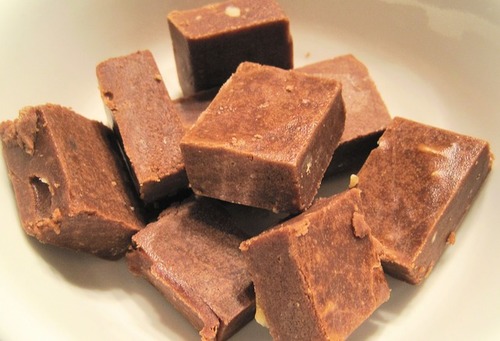Short answer
Fudge is pretty much nothing but empty calories - fat and sugar. Still, the type of fat it contains does have antioxidants and fudge made at home is free from harmful additives. It's certainly not good for your health, but in moderation, shouldn't cause any damage.
Recommended Alternative
Harmful to your health. A few benefits may be associated, but the bad outweighs the good. Moderation is extremely important.
View Full Grading System
Category 'A'
Very healthy and numerous health benefits. Side effects are rare. Things rated an 'A+' are typically necessary for survival (for example, water).
Very healthy and numerous health benefits. A few harmful qualities may be associated, but only under certain circumstances such as an allergic reaction.
Very healthy and numerous health benefits. Harmful qualities may be associated, but aren't usually serious.
It is important to note that even the best things in life can become bad in immoderate amounts. So, although something may be rated an 'A+', overconsumption/overdoing can bring unwanted effects.
Category 'B'
Very beneficial to your health. Things rated a 'B+' may have a few harmful qualities to pay attention to.
Overall beneficial to your health. Things rated a 'B' may have some harmful qualities to pay attention to.
More beneficial to your health than not. However, harmful qualities are most likely associated and shouldn't be overlooked.
The main difference between category 'A' and category 'B' is the harmful qualities typically present in 'B' items. Serious side effects are usually uncommon, but are still possible and should be taken note of.
Category 'C'
Both beneficial and harmful qualities associated. Things rated a 'C+' are typically a bit more on the beneficial side. Still, moderation is important.
A fairly even ratio of beneficial and harmful qualities. Moderation is important. Very general topics that can lean towards both sides of the spectrum will be placed here as well. Rice, for example, can be good or bad depending on the type.
More harmful than beneficial. Side effects are common, especially when consumed/done excessively. Moderation is very important.
Category 'C' usually denotes to both good and bad qualities. When it comes to this category, it is important to keep this word in mind: moderation.
Category 'D'
Harmful to your health. Although benefits may be associated, the bad most likely outweighs the good. Moderation is very important.
Harmful to your health. A few benefits may be associated, but the bad outweighs the good. Moderation is extremely important.
Harmful to your health. Very few, if any, benefits are present. Things in this category should be avoided as much as possible.
Category 'D' is typically for things that are more harmful than beneficial. While consuming/doing something unhealthy once in a blue moon shouldn't hurt, we definitely recommend eliminating 'D' items as a regular part of your routine/diet.
Category 'F'
Category 'F' is for things that fail to bring anything beneficial to the table, and are very harmful to your health. We recommend completely avoiding anything in this category. Long-term side effects of 'F' items are usually very serious.
Category 'N'
'N' stands for neutral. Things placed into this category are generally (a) neither good nor bad for you, or (b) lack the necessary evidence to reach any conclusions.
Long answer
Fudge can be made in a variety of ways and depending on whether it is homemade or mass-produced, may or may not contain various additives. This article will be concerned with additive-free fudge - the kind you make at home or get from a restaurant that makes its own fudge. There are four main ingredients in fudge: sugar, milk, butter, and whichever flavor you want your fudge to taste like. In order to keep the smooth texture, people also often add milk fat and corn syrup. These ingredients are then heated up to between 235-240 degrees Fahrenheit. Basically, what you are getting is a calorie-filled dessert that will not provide you with any vitamins or minerals. For example, chocolate fudge, which contains about 140 calories per piece, has a high fat content, taking up nearly 1/4 of the calories. Saturated fat is also pretty high, with about 10% of the daily value.
One of the main contributors to saturated fat is milk fat, which has been found to contain over 400 fatty acids. While saturated fat is said to be ok in small quantities (no more than 5-6% of your daily caloric intake), excessive consumption can increase your levels of 'bad' LDL cholesterol. High levels of this kind of cholesterol is a primary cause of both atherosclerosis and heart disease.
Fudge is also very high in sugar, which can lead to blood sugar spikes, weight gain and all the risks associated with obesity - including diabetes and, once again, heart disease.
The good news is that fudge can be made without sugar. For example, if making a fruit fudge, the fruit produce natural sugar (fructose). Another option is to use an artificial sweetener - just be sure to get one that is safe!
Possible short-term side effects
- nausea
-
bloating
-
blood sugar spike
Possible long-term side effects
- weight gain
-
inflammation
-
increased cholesterol
-
heart disease
-
diabetes
-
atherosclerosis
Ingredients to be aware of
Benefits
- free of additives (if homemade)
-
contains antioxidants
Healthier alternatives
Our Wellness Pick
(what is this?)
Lily's Dark Chocolate Cups
- No added sugar
- Low-carb, Keto-friendly
- Fair Trade certified
- Gluten-free & Non-GMO
- Sweetened with Stevia
Learn More!
Please turn your Ad Blocker off to see this content. Thank you!
Thank you for your feedback!
Written by Jeff Volling
Published on: 12-29-2015
Last updated: 12-15-2023
Thank you for your feedback!
Written by Jeff Volling
Published on: 12-29-2015
Last updated: 12-15-2023

 Approved by
Approved by 















